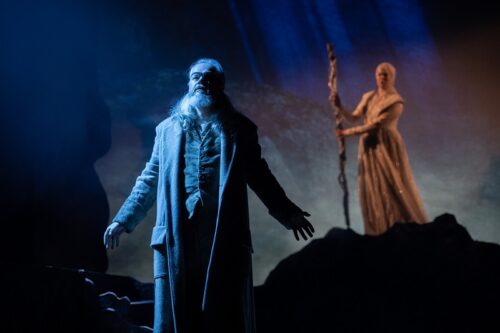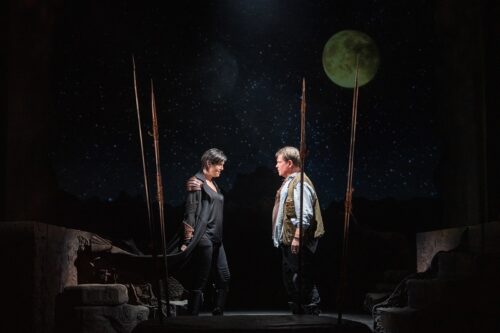 United Kingdom Longborough Festival Opera 2022 [1] – Wagner, Siegfried: Soloists, Longborough Festival Orchestra / Anthony Negus (conductor). Longborough, Gloucestershire, 1.6.2022. (JPr)
United Kingdom Longborough Festival Opera 2022 [1] – Wagner, Siegfried: Soloists, Longborough Festival Orchestra / Anthony Negus (conductor). Longborough, Gloucestershire, 1.6.2022. (JPr)

Production:
Director – Amy Lane
Set and Props designer – Rhiannon Newman Brown
Lighting designer – Charlie Morgan Jones
Costume designer – Emma Ryott
Video designer – Tim Baxter
Choreographer – Lorena Randi
Cast:
Siegfried – Bradley Daley
Mime – Adrian Dwyer
The Wanderer – Paul Carey Jones
Alberich – Mark Stone
Fafner – Simon Wilding
Woodbird – Julieth Lozano
Erda – Mae Heydorn
Brünnhilde – Lee Bisset
In my recent review of Richard Jones’s Samson et Dalila at Covent Garden I was reminded of the great furore over his Ring cycle at Covent Garden in the 1990s, and how at a public event the director responded to a question of what it was supposed to ‘mean’ with ‘Well, what does it mean to you?’ Since then – but I guess also from the first time I ever watched opera – I have wanted what I am seeing to resonate with me on some level or other. This is especially with a developing Ring where there is also the hope that in the journey through the operas there will be something of ‘the great idea’ to be discovered. I searched for this in vain through Stefan Herheim’s new Ring for Deutsche Oper Berlin (available on Marquee TV) and it is still too early to conclude what meaning, if any, Amy Lane at Longborough wants us to gather from what she is putting on stage in her ongoing new cycle. However, I appreciated – especially when this performance took off in the final act – the beautiful video backdrops and generally clear storytelling that were a highlight of this Siegfried which held my attention throughout, along with its solid musical values.
Siegfried is often derided as the least popular of the four Ring operas, yet, revealing my perversity, it has always been my favourite. Lane’s Ring is juddering to its completion in 2024 having been blighted – as so much has – by the pandemic. There was a fully-staged Das Rheingold in 2019 (review here) and Die Walküre was a socially-distanced semi-staging and we really have no idea how the errant Valkyrie, Brünnhilde, was put to sleep on her rock as punishment for defying her father Wotan’s authority. She will be awoken by the ‘hero that knows no fear’ and he is Siegfried, the result of the incestuous relationship of his parents Siegmund and Sieglinde which is the subject of Die Walküre. Not only does Siegfried not know fear, but he also does not know love either and it takes the awakened Brünnhilde to arouse that in him during Wagner’s blazingly transcendent finale.
It was this final act that won me over to this Siegfried. Anthony Negus, Longborough Festival Opera’s music director, reflected on the twelve-year gap in Wagner completing the opera and how, ‘In that act, a whole new atmosphere comes into being: vividly in the marvellous prelude, and we hear it, too, in the scene between the Wanderer and Erda.’ Negus and his 60-strong orchestra sounded transformed after the second interval, not that they were in anyway ‘bad’ before that but it was all rather more routine than we have come to expect from them. Perhaps Alfons Abbass’s reduced score was the problem, however the same number of musicians in Act III sounded twice the size of those we had heard before. This third act was conducted with considerable passion, transparency and consummate authority. Whilst there was no doubting Negus’s deep understanding elsewhere in this opera, there seemed something of a matter-of-fact briskness to it, though conversely some of the more narrative passages lingered more than I expected them to.
Set and Props designer Rhiannon Newman Brown populated Mime’s dwelling with eclectic odds and ends including a flipchart where Mime draws where the sword Nothung came from, an armchair, an anvil, oil drums, amongst much else. At the end when Siegfried sings ‘So schneidet Siegfrieds Schwert!’ he just swings about the sword he has forged and nothing else happens. How difficult could it have been for him to cleave in two the rotary line that Mime and Siegfried’s washing was on? At the end of the first act a slight figure in evening dress appears and totally confuses many in the audience – clearly not au fait with the opera – who didn’t realise the act was actually over. That was the Woodbird of course.
In Act II there is more of a suggestion of a rocky landscape though Fafner is totally misconceived as someone physically impaired and with crutches. He is guarding the gold that includes the ring and Tarnhelm (his top hat) that Siegfried claims when he kills him. The Woodbird appears to be Siegfried’s Nicklausse-like muse who is constantly scribbling in a notebook and whether what is written there is what’s happening, or whether something already written is being followed, is unclear. It was slightly reminiscent of the way Herheim uses Wagner’s scores in his Berlin production.
In Act III Erda, ‘the world’s wisest woman’ and Brünnhilde’s mother, makes a magical appearance at the back, but Longborough’s restricted stage means that Brünnhilde cannot simply be discovered sleeping on her rock and is lead in by the Wanderer to lay down on it surrounded by a cat’s cradle of spears.

As I mentioned earlier, Tim Baxter’s use of projected imagery (still or moving) makes more of these stage pictures than might be there otherwise. These are so many and varied that I can only give a hint about them all; there are the forest settings for the caves Mime and Fafner live in, trees, a bear, a dragon’s green scales, mountaintops, the waters of the Rhine, sunrises and sunsets, and ending with a blazing sun followed by a starry sky during the last few moments of the opera. Emma Ryott’s costumes at times had more than a hint of J R R Tolkien to them with Alberich as a hobbit and the Wanderer (blatantly?) as Gandalf.
Sadly I must – as many would – disagree with Negus when he suggests that Wagner did not want his Mime to sing the role ‘in an ugly way, or as a caricature’. For me Mime is a nastier piece of work than Siegfried and it is clear Mime has only brought him up so he can fight Fafner and get the hoard of gold for himself. No one would want Mime portrayed as the ‘dwarf’ he is constantly referred to as, but Adrian Dwyer looked incongruous and his voice was more suitable for Loge. Nevertheless, his Mime had its moments especially when entertainingly flouncing around in an apron – and sometimes with a chef’s hat – whilst cooking up his poisoned soup.
Three singers in smaller roles were mightily impressive: Mark Stone’s power-hungry and vengeful Alberich, Simon Wilding’s unusually poignant Fafner and Mae Heydorn’s bewildered Erda which she sang with focussed intensity and contralto richness. However, Julieth Lozano was too forthright as the Woodbird and as intriguing as the character was, who actually was this chronicler?
Paul Carey Jones came into his own as the Wanderer in his confrontations with Erda and then Siegfried, at these moments he was at his most dignified and vocally commanding. Lee Bissett sang Brünnhilde with great fervour though her resplendent voice seemed to lack some of the security of previous years, though she sounded as if she was just getting warmed up as the opera finished. I had admired Bradley Daley as Siegmund in a Melbourne Opera livestream (review here) and he didn’t disappoint me here. Any Siegfried who can outsing his absolutely fresh Brünnhilde after so many hours must be doing something right. Daley sang his overgrown man-child with a bright, stentorian top, some grace and an attention to phrasing that came and went (possibly in passages where he was unconsciously saving himself for his big finish).
Jim Pritchard
